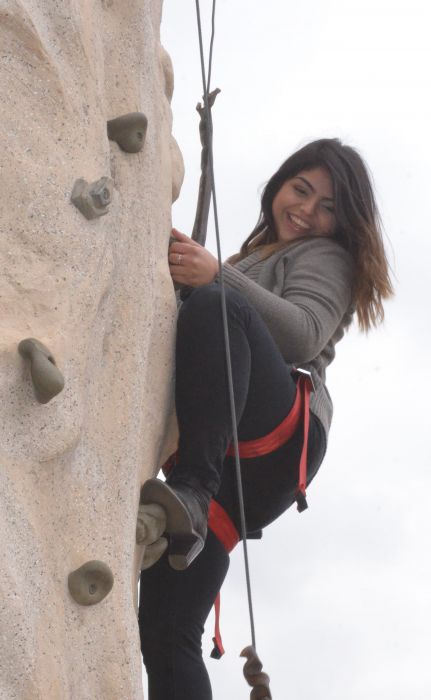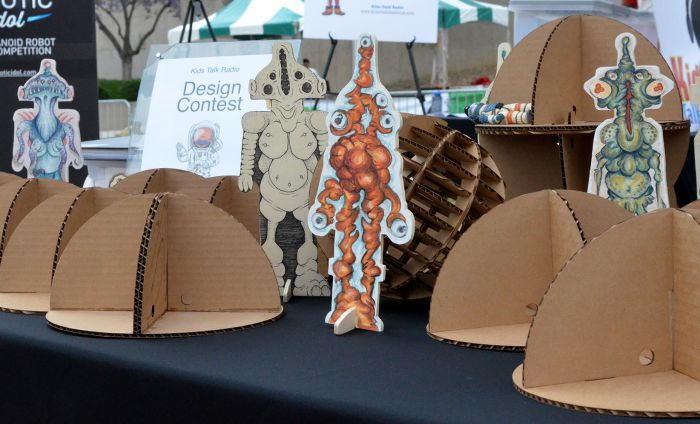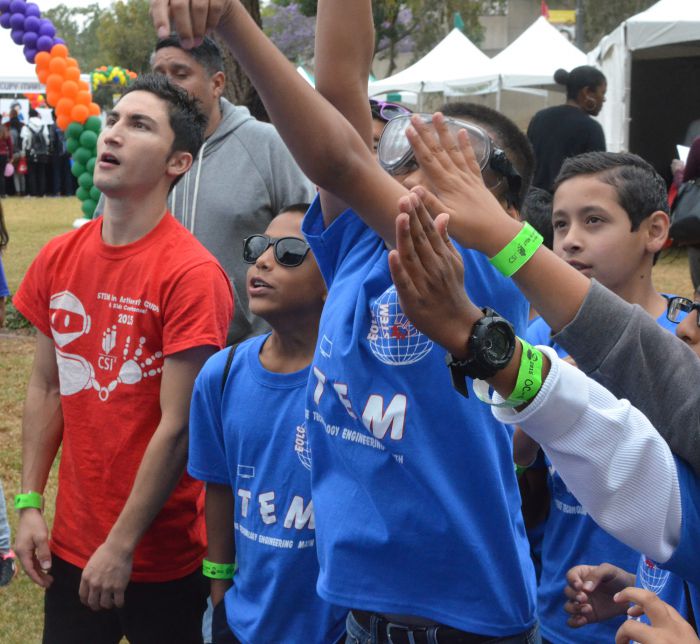Scaling a rock wall to learn about human energy output, discovering why solar tubes float, and launching paper rockets to put Newton’s Law to the test are just a few of the learning activities that were offered to local school children during the first “STEM in Action: A Kid’s Conference” at California State University, Dominguez Hills (CSUDH).
Hosted on May 5 by the California STEM Institute for Innovation and Improvement (CSI3), a component of the Center for Innovation in STEM Education (CISE) at CSUDH, the conference featured a dozen booths designed to stir wonder, arouse the imagination and evoke the ingenuity of the nearly 450 K-12 students who attended the conference.

“The overall goal today is to increase awareness in STEM for the students. They only learn math and science within four walls at their schools, so they don’t have an opportunity to experience math and science–STEM in general–in a way that comes to life for them. We at CSUDH want to help change that,” said Kamal Hamdan, director of CISE. “CSU Dominguez Hills is always finding ways to inspire the next generation of STEM professionals. Every one of these booths has a STEM lesson plan for the students, and each lesson consists of integrating math and science.”
Hamdan said an equally important goal of the conference is to enable CSUDH students who are teacher candidates to experience project-based learning through STEM (science, technology, engineering and mathematics) activities so they can connect those activities to theories that they’ll be learning through the credential program and can apply them when teaching in the classroom.
The “Occupy Mars Learning Adventures Design Contest” was among the most popular stations at the conference. It invited students to compete for prizes and to have their work displayed on the Kids Talk Radio website by building robots and model-sized dwellings out of cardboard for the potential future colonization of the red planet.
Deandre Minor, a CSUDH mathematics major and a Noyce Scholar, worked the Occupy Mars station and provided the young participants information about the competition. The students also had the opportunity to check out a previously built model of a Mars city, which provided a peek at the quality of work needed to compete well in the competition.
“The conference helps me connect with these kids in many ways. Since I’m going to become a mathematics teacher, spending time with them in this way is a great way to learn how they interact, both with us and each other,” said Minor.
Minor added, “It’s hard to get involved in STEM at an older age because you’ve already lost interest in it. That’s why we want young students like these to know that STEM is important for everything; that it’s used in almost all the stuff we need in life.”
Conference volunteers included CSI3 staff and student assistants, as well as students enrolled in various teacher education programs at CSUDH: the Noyce Scholars Program, the Math and Science Teacher Initiative Program, Project REACH, Transition to Teaching Online, and those from the STEM Teachers in Advanced Residency program. Los Angeles Unified School District (LAUSD) teachers also lent a hand.

The students and their teachers who attended the conference traveled from schools throughout CSUDH’s service area, as well as schools within LAUSD and the Heber School District in El Centro. Both districts currently have partnerships with the university.
Sara Hernandez, a 6th grader at Gage Middle School in Huntington Park, was one of the students who participated in the variety of hands-on learning opportunities at the conference to discover the numerous possibilities in STEM fields.
“I like science a lot. It’s really fun, especially with our teacher, Kristi Hayes (’09, M.A., education]. She doesn’t make it seem boring, she always adds a little pizazz,” said Hernandez. “I liked the bubble booth. It was interesting how the bubbles would pop and dry up then form the residue on your finger that they use to make bubbles that don’t pop.”
Hernandez was referring to how bubble solution is made for bubble-blowing toys. “No-pop bubbles” begin as a regular soap and water bubble solution. To this is added a small amount of non-toxic water-soluble polymer. As water evaporates from the bubble’s surface, an extremely thin plastic bubble skeleton remains, which has the properties for which no-pop bubbles are made.
Hayes, who teaches 6th grade science and English, knows firsthand the importance of introducing STEM education early to students.

“STEM is the future. It’s going to be the way that we fix a lot of the world’s issues, such as the drought,” she said. “Studies show that if students don’t get interested in science by the end of 7th grade they never will. So we’re engaging students early to capture their imagination and curiosity and teach them how they can use it to make the world better.”
Mattel’s “Mini-Collision Course” offered students a unique way to learn about potential and kinetic energy by observing, predicting, measuring and exploring the effects that the height of the ramps has on the transfer of energy as the result of a collision between two Hot Wheels cars.
Working in small groups, the students built ramps out of Hot Wheel tracks in a U shape and dropped two cars down the tracks from either side to create collision in the middle. They measured the potential and kinetic energy of the cars as they traveled down the ramps and the distance they moved as a result of each collision. After measuring the results, they created a way to record the data and present their findings to their classes.
Adriana Navarro, a liberal studies major with a science option at CSUDH and a MSTI Scholar, took a turn climbing the rock wall, a challenging activity she was helping manage during the conference. “I got an adrenaline rush climbing this wall, but unfortunately didn’t make it all the way up,” she said.
“The rock wall is an experiment for students to figure out how much work they’re doing when climbing the wall,” said Navarro. “First they weigh themselves. After climbing from the bottom to the top, the amount of work they’re putting out to get to the top is determined by their weight [mass] multiplied by the approximate acceleration of gravity, and then multiplied by the height, which is eight meters [the height of the wall].”

John Lira, who is studying conflict resolution at CSUDH and is a Project Reach participant, operated the basketball shooting game at the conference. The popular arcade game served a dual purpose: it proved to be a lot of fun for the young students and it used science to show how the human brain perceives where a person is in space.
“My booth has to do with vision, showing students what happens when what we see doesn’t match up with where our brains think they are,” said Lira. “The students are learning how to see things they’re not really conscious of all the time; that vision is not just what you see with your eyes, but what you see with all your senses working together.
“They’re shooting baskets, then we impair their vision with prism googles that shifts and distorts light, which, to them, changes where they believe their bodies are in space,” added Lira. “So they have to learn to adapt on the spot, which they do. But once we remove the goggles they readjust their sight back to normal quickly. This is a great way for them to get involved and see how STEM can be both fun and educational.”